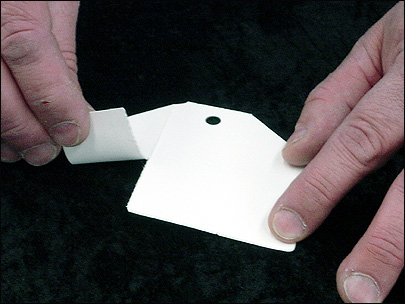Marnlen RFID, a division of label maker Marnlen Management, has licensed IBM‘s Clipped Tag, a design allowing consumers to tear off most of a passive RFID tag’s antenna on purchased items. Hangtags based on the Clipped Tag design are production-ready, says Andris Lauris, Marnlen’s vice president of business development, and sample tags have been shipped to several of IBM’s 10 Centers of Excellence for demonstration to prospective customers. In addition, Lauris says, Marnlen is working with unnamed potential customers, such as garment retailers and the pharmaceutical industry, to pilot the tags.
IBM researcher Paul Moskowitz developed the Clipped Tag last year at IBM’s Watson Research Center. In November 2005, he presented it at the Conference of Computer and Communications Security, hosted by the Association for Computer Machinery (ACM) in Alexandria, Va., as a solution to privacy concerns over item-level tagging (see IBM Proposes Privacy-Protecting Tag). A primary privacy concern was that an unauthorized person might be able to use an RFID interrogator to read the tags on purchased items carried by a consumer, and identify those items. After further research into several form factors, Watson found the best solution to be perforations that let the consumer tear off most of a tag’s antenna, reducing the operational range to a very short distance, Moskowitz says.
The Clipped Tag measures 4 inches by 3 inches and has a perforated line across each half of its dipole antenna. Once its sides are torn off along those perforations, the tag remains operable, but its read range is reduced from 20 feet to a matter of several inches. In this way, consumers can make the tag unreadable unless presented directly in front of an interrogator, says Moskowitz. Therefore, if a customer needed to return an item, the store could use a stationary or handheld interrogator to read the tag within close range, but others would not be able to read it from a distance.
Marnlen is using the Clipped Tag design for Alien Technology ALL-9440 (Squiggle 2.2) EPC Gen 2 UHF inlays in a printable hangtag for garments or other retail items. The hangtag can be printed on any RFID label printer and was tested with a Printronix SL5000r MR2 printer. According to Lauris, the Clipped Tag hangtags will cost no more than any other garment hangtag using RFID.
To educate consumers about the Clipped Tag, stores would be expected to post information about what it is, how it works and how its transmission range can be reduced. A purchaser of a tagged garment could then decide whether to tear off the tag’s antenna poles at the time of purchase. “In this way,” Moskowitz says, “the consumer has a choice.”
The tearing option employed for the Clipped Tag, he explains, was deemed preferable to two other solutions that had been researched: the blocker tag and the scratch-off tag. In the case of the blocker tag, consumers would carry an RFID tag designed to render nearby tags difficult to read. That was not as convenient for consumers, who would be responsible for keeping such a tag with them. In the case of the scratch-off tag, Moskowitz says, it would have included a small strip of printed electrical conductor to link the chip and a short portion of the tag’s antenna to the larger part of the antenna. To shorten the read range, consumers would have to scratch off the conductor with a hard object, such as a penny. This solution would have been less convenient for the consumer and more complex to manufacture, he says.
Although Marnlen developed its Clipped Tag for garments and other retail items, Lauris says he expects customers to ask for other forms of the tag for a variety of applications, including pharmaceutical use. His firm has also created a prototype label that is attachable to an item’s cardboard packaging, such as a milk carton or a box containing a coffeemaker or other appliance. The prototype has two strips that can be pulled to break off the poles of the antenna.


